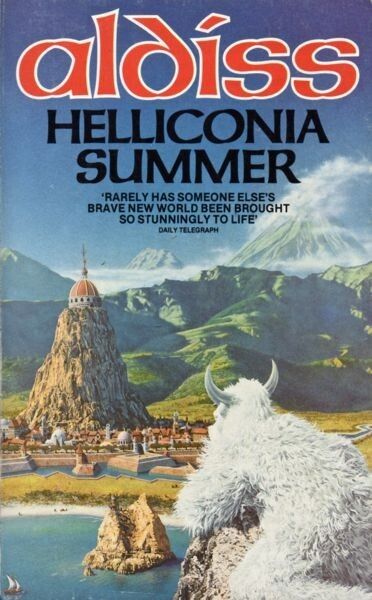Cruel, Cruel Summer
Helliconia Summer (Helliconia, volume 2)
By Brian W. Aldiss

11 May, 2021
1983’s Helliconia Summer is the middle volume in Brian Aldiss’ Helliconia trilogy.
Helliconia’s climate is driven by the proximity of Helliconia to the giant star Freyr, about which Helliconia and its sun Batalix orbit. Currently Batalix and Helliconia are approaching periapsis and temperatures are soaring. Many devout people in the tropical continent Campannlat fear Freyr will consume them all.
Unbeknownst to Helliconia’s natives, their activities are monitored from above by the space station Avernus. Certain curious practices on Avernus will greatly complicate the already fraught politics of the kingdom of Borlien.
Borlien is a kingdom perpetually struggling with rivals. It is handicapped by lagging military tech; its alliances are shaky. These shortcomings led to an embarrassing military setback for King JandolAngonal: a brutal drubbing by enemies that the kingdom Borlien had dismissed as inferior. JandolAngonal schemes a comeback. He has a cunning plan.
Borlien needs to shore up its alliances. There is no better basis for alliance than a strategic dynastic marriage. Accordingly, JandolAngonal resolves to unite Borlien’s royal family with the House of Stund of Oldorando. Ideally this would involve a marriage between JandolAngonal’s son RobaydayAnganol and Oldorando’s Princess Simoda Tal. Alas, RobaydayAnganol prefers to frolic with barbarians and is unsuitable for marriage, dynastic or otherwise. Therefore, JandolAngonal must marry the princess himself, which means JandolAngonal must find a pretext to divorce his current wife, the beloved Queen MyrdemInggala.
Meanwhile, high in orbit above the planet, Avernus orbits. Human starships are blindingly fast, two-thirds the speed of light, but not only are interstellar distances vast, worlds with complex life, worlds such as Earth and Helliconia, are vanishingly rare. A thousand light-years separate Earth and Helliconia. The scientists monitoring Helliconia are descendants of people created in the Batalix system by robotic uterine replicators dispatched from Earth. They can never travel to the Solar System because the distances are too large for even cold sleep to defeat. Helliconia itself is home to viruses lethal to humans. Avernus is both scientific post and prison.
Among Avernus’ curious social adaptations to its circumstances is the practice of periodically sending a lucky volunteer down to the surface of Helliconia to enjoy the world first-hand for as long as it takes the viruses to kill them. The latest voyager is Billy Xiao Pin, who is for the most part unremarkable … with one exception. He is obsessed with Queen MyrdemInggala.
~oOo~
Women in this setting are second-class humans, who can, however, occasionally be valuable resources. They are strongly discouraged from any form of personal ambition. Clearly not every woman has received the memo; MyrdemInggala resists being discarded despite assurances it is in the best interest of the state. There are a few other examples of women with agency, but on the whole the treatment of women in this Reagan-era book is rather Eisenhowerian. Or perhaps Thatcher-era or “Churchillian” would be more apt, as we’re discussing the work of a British author.
There is no causal link between the evolution of humans on Earth and the evolution of the humans on Helliconia. Given how alien the phagors (the other intelligent race on Helliconia) are, one has to wonder how it is that two such similar species arose almost simultaneously on two unrelated worlds.
A minor part of the backstory is that Earth stopped exploring the galaxy because worlds like Earth and Helliconia are so rare. While such worlds are infrequent, there are enough stars in the Milky Way that if the Earth-Helliconia separation is average, there must be ten thousand or so planets with complex life forms. Not that this knowledge does anyone on either Helliconia or Earth any good, because the distances are sufficient to prevent personal travel.
Given that Avernus was built remotely and has functioned as planned for thousands of years, humans don’t need Terrestrial planets to live on. They have the technology to settle even inhospitable worlds. The main reason they don’t do this seems to be that absent interesting biospheres to study, they don’t see compelling reasons to bother. It’s just one more thing that contributes to the somewhat morose tone of the novel. Individuals may care passionately about their own lives, but such lives are irrelevant to the broader sweep of history. The novel cares more about history than individuals.
This volume spans much less time than the first. Oddly, this is to its detriment. Aldiss’ castle opera is competently executed, with many twists and surprises, but I missed the earlier novel’s sweeping survey of Helliconian civilizations and their curious adaptations to unusual circumstances. Pity, because the trilogy is a fascinating exercise in world-building, as Aldiss applies James Lovelock’s Gaia Hypothesis to a science fictional planet.
Helliconia Summer is available here (Amazon US), here (Amazon Canada), here (Amazon UK), here (Barnes & Noble), and here (Chapters-Indigo). It is listed here (Book Depository) but does not seem to be available for purchase.
